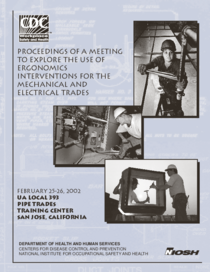Proceeding of a meeting to explore the use of ergonomics interventions for the mechanical and electrical trades, San Jose, California, February 25-26, 2006

Albers, Jim ; Estill, Cherie ; MacDonald, Leslie A.
USA. National Institute for Occupational Safety and Health
NIOSH - Cincinnati
2006
140 p.
conference report ; ergonomic evaluation ; ergonomics ; industry ; musculoskeletal diseases ; occupational injury
NIOSH Publication
119
Ergonomics and work environment
English
Bibliogr.
"In February 2002, 60 researchers, contractors, and trades people representing the piping (or plumbing), heating and air-conditioning, and electrical sectors of the U.S. construction industry attended a meeting titled, Exploring Ergonomics Interventions in the Mechanical and Electrical Construction Trades in San Jose, California. The 2-day meeting was organized by researchers at the National Institute for Occupational Safety and Health (NIOSH). The meeting attendees consisted of 39 industry trades people and 21 researchers from academia and government. The format of the meeting included presentations describing work-related musculoskeletal disorder (WMSD) risk factors and injury or illness data for the mechanical and electrical trades, as well as trade-specific breakout sessions. Edited transcripts of the presentations with questions and answers are included in the proceedings as documentation of the meeting. The content, however, might not reflect current NIOSH policy or endorsement. This summary focuses on the activities and results of the three breakout sessions. Participants agreed that the mechanical and electrical trades are at risk for developing WMSDs and identified interventions currently available to attenuate certain recognized risk factors. Site management and work organization were considered critical to reducing many problems, as well as in facilitating the implementation of interventions. Early contractor involvement in a project (e.g., design-build contractors) could influence design decisions that, in turn, could reduce worker exposures to WMSD risk factors. Factors that influenced use of commercially available interventions include the start-up costs, effects on productivity, and craft traditions. Although there was a consensus regarding the need to evaluate the effectiveness of new interventions, many participants said they would use them after less rigorous personal or anecdotal verification. The discussions and recommendations that occurred during the course of the breakout sessions and the plenary sessions suggested the following conclusions: 1. Workers employed in the electrical, pipe, and sheet metal trades are exposed to risk factors for WMSDs; 2. WMSD risk factor conditions common to the three trades include MMH, work location (e.g., ceiling, floor), and the continuously changing building site; 3. WMSD risk factor conditions unique to the three trades include the type of materials, tools, and equipment used; 4. Ergonomic principles have informed the design and performance of commercial hand tools, but additional tool design is needed to reduce exposures to biomechanical stressors; 5. Ergonomic interest in increasing worker productivity has resulted in greater use of powered equipment to transport materials and to lift and position workers and materials above floor level. Interventions are not currently available for all high-risk jobs, and research should be directed to address this gap."
Digital
The ETUI is co-funded by the European Union. Views and opinions expressed are however those of the author(s) only and do not necessarily reflect those of the European Union or the ETUI.